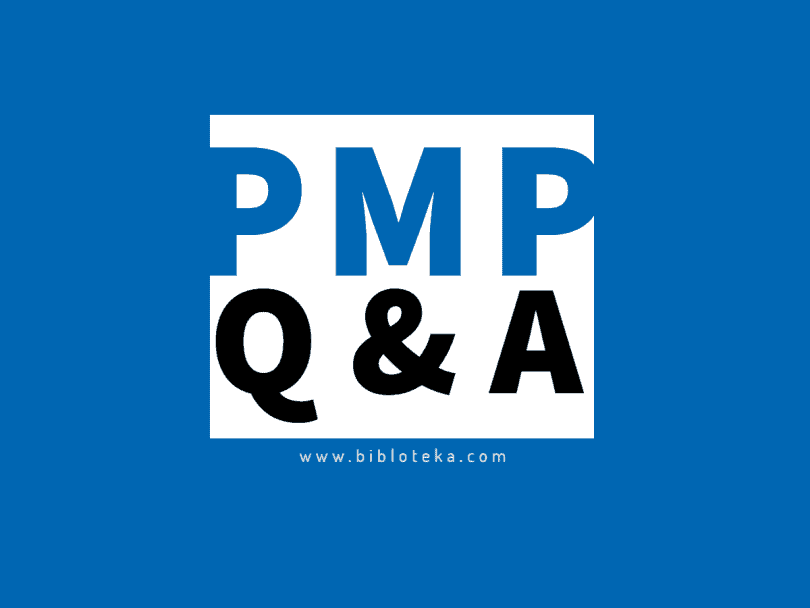1-If a project manager believes that a particular subcontract needs to be terminated, which of the following can provide guidance on the contract termination procedure?
A. The contract termination procedures in the organizational process assets
B. The termination clause of the specific subcontract
C. The change control procedures in the project management plan
D. The contract termination procedures in the project procurements management plan
Correct Answer:
B. The termination clause of the specific subcontract
Feedback:
Each contract is distinctive, as are its responsibilities, regulations, and regulations. Any contract that needs to be terminated must be terminated in accordance with the termination clause of that contract. These contract termination provisions are agreed and signed off by both parties at the time of the contract award. [PMBOK 6th edition, Page 489] [Project Procurement Management]
2-The process of creating WBS identifies the outputs at the __________level in the Work Breakdown Structure (WBS).
A. Lowest
B. Any
C. Tenth
D. Highest
Correct answer:
A. Lowest
Feedback:
The process of creating WBS identifies the work package at the lowest level in the WBS. Typically, project work packages are decomposed into smaller parts called activities, representing the work needed to finish the work package.. [PMBOK 6th edition, Page 157] [Project Schedule Management]
3-Few project managers collect lessons-learned information throughout the project’s life. Most tackle this in the final days of the project or, worse after the project is complete. What is the negative consequence of this approach?
A. It makes it difficult to compile and obtain information about the project.
B. It could result in additional project expenses.
C. The project’s NPV becomes zero.
D. It requires a specialist to be hired to do the job.
Correct answer: A
Feedback:
When lessons-learned gathering and documentation is postponed until the very end, the project manager must scramble for bits and pieces of project history to compile into a lessons-learned document. Often, because the project is in the closing phase, only a few team members are left to the project manager, making it hard to compile and obtain project data from the remaining few funds. [PMBOK 6th edition, Pages 98, 100] [Project Integration Management]
4-Which of the following statements most accurately describes a project scenario?
A. Changes in the scope of the project during the project’s original stages are very costly.
B. The influence of the stakeholders is the same all through the project.
C. Staffing peaks during a project’s execution phase.
D. The next phase of a project should never start until the deliverables for the previous phase are completely reviewed and approved.
Correct answer: C
Feedback:
Employment is typically the highest during the project’s execution stage. The other three responses may not hold true. Projects can move into subsequent stages without the complete approval of the results of the previous stage; this is known as rapid tracking. Changes during the project’s original stages are the least costly. The influence of the stakeholders is highest during the start of the project and declines as the project moves to completion. [PMBOK 6th edition, Page 549] [Introduction]
5-During the Manage Stakeholder Engagement process, a number of project documents might get updated. Which of the following project documents will be most updated during this phase?
A. Stakeholder register
B. Risk register
C. Project reports
D. Project presentations
Correct answer:
A. Stakeholder register
Feedback:
During this phase, project reports and presentations distributed to stakeholders are stored in the assets of the organizational process. Stakeholder register is the most updated project document during this phase.. [PMBOK 6th edition, Page 529] [Project Stakeholder Management]
6-As you create the Activity List, which technique is recommended for subdividing the project into smaller components called activities?
A. Decomposition
B. Rolling Wave Planning
C. Expert Judgment
D. Deconstruction
Correct answer:
A. Decomposition
Feedback:
The method of decomposition enables the project manager to generate smaller and more manageable job parts from the bigger job packages. [PMBOK 6th edition, Page 185] [Project Schedule Management]
7-Which of the following components of a project scope statement is useful in reducing scope creep?
A. Acceptance criteria
B. Deliverables
C. Scope description
D. Project exclusions
Correct answer:
D. Project exclusions
Feedback:
Exclusions of projects define what is excluded from the project. Explicitly stating what is out of scope for the project helps manage stakeholders’ expectation and can reduce scope creep. Other choices cannot help more in this regard. [PMBOK 6th edition, Page 154] [Project Scope Management]
Management]
8-During the development of the project stakeholder engagement plan, the project manager is usually dependent on the expert judgment of senior stakeholders to identify and plan effective stakeholder management strategies. Which of the following stakeholders cannot guide the project manager in the development of efficient inner stakeholder policies?
A. Project Management Office (PMO)
B. Identified key stakeholders
C. Customers
D. Project team members
Correct answer:
C. Customers
Feedback:
Only inner stakeholders can provide inner stakeholders with expert judgment on efficient leadership policies. Project customers are important stakeholders but usually, they lack the knowledge of internal stakeholders, and hence cannot provide accurate feedback. [PMBOK 6th edition, Page 550] [Project Stakeholder Management]
9-Which of the following is not an organizational process asset used during the Plan Resource Management process?
A. Template for the resource management plan
B. Resource management policies and procedures
C. Historical information about previous projects
D. Standardized stakeholder list
Correct Answer:
D. Standardized stakeholder list
Feedback:
Standardized stakeholder list is not a valid organizational process asset used in the Plan Resource Management process. The other choices are valid assets. Other assets include historical data about organizational structures that operated in past projects and organizational procedures and policies. [PMBOK 6th edition, Page 315] [Project Resource Management]
10-Various tools and techniques determine project requirements during the Collect Requirements process. The foundation for identifying the scope of the project is these conditions. During this exercise, one of the project manager’s responsibilities is to identify key project outcomes. Where are the key project deliverables documented?
A. Scope Management Plan
B. Requirements Management Plan
C. Project Scope Statement
D. Accepted Deliverables
Correct answer:
C. Project Scope Statement
Feedback:
The scope statement of the project provides a description of the product, acceptance criteria, key deliverables, project boundaries, assumptions, and project constraints. The scope management plan and the requirements management plan are the subsidiary plans of the overall project management plan, detailing how the project team needs to manage the scope and requirements of the project, respectively. These plans do not document the actual scope of the project. Accepted Deliverables is the wrong answer as deliverables are approved after completion and validation, the main deliverables are identified early during the project’s scheduling stage. [PMBOK 6th edition, Page 154] [Project Scope Management]
11-After brainstorming potential project risks, what is the recommended method for prioritizing these risks and their mitigation plans?
A. RACI chart
B. Control chart
C. Fishbone diagram
D. Probability & impact matrix
Correct Answer:
D. Probability and impact matrix
Feedback:
A matrix of probability and effect will assist filter the other high-risk items and high-impact items so you can concentrate on those more risky products. [PMBOK 6th edition, Page 425] [Project Risk Management]
12-What is the primary risk when including reserves, or contingency allowances, in your cost estimate?
A. Canceling your project
B. Understating the cost estimate
C. Overstating the cost estimate
D. Tracking the funds
Correct answer:
C. Overstating the cost estimate
Feedback:
Contingency funds are used to handle cost uncertainty due to unforeseen events during a project. These funds are generally used for items that are likely to occur but are not certain to occur. [PMBOK 6th edition, Page 245] [Project Cost Management]
13-If you are managing changes to the project’s cost baseline, which process are you using?
A. Negotiate Costs
B. Estimate Costs
C. Control Costs
D. Determine Budget
Correct Answer:
C. Control Costs
Feedback:
Control Costs is the method of handling the cost of the project and the modifications affecting the bottom line. [PMBOK 6th edition, Page 257] [Project Cost Management]
14-For multiple purposes, a number of documents may be updated during the Control Procurements phase. Which of the project-management plan’s following parts are least probable to be updated during this process?
A. Quality management plan
B. Procurement management plan
C. Schedule baseline
D. Cost baseline
Correct answer:
A. Quality management plan
Feedback:
The procurement management plan, schedule baseline, and the cost baseline typically get updated as a result of a significant change in procurement contracts or strategy. However, during this phase, the quality management plan is less probable to be updated as all contractors always have to meet quality demands. Contractors may be allowed more money or time to complete the works, but the quality of the works cannot be compromised. [PMBOK 6th edition, Page 500] [Project Procurement Management]
15-The most detailed level of the WBS is the _______________ *
A. Control Account
B. Work package
C. Scope statement
D. Accepted Deliverable
Correct answer:
B. Work package
Feedback:
The work package is the WBS ‘ smallest and most comprehensive level and can be planned, estimated price supervised, and controlled. [PMBOK 6th edition, Page 157] [Project Scope Management]
16-Which of the following is a hierarchical representation of project risks?
A. Risk Register
B. Risk Mitigation
C. Risk Categories
D. Risk Breakdown Structure
Correct Answer:
D. Risk Breakdown Structure
Feedback:
The Risk Breakdown Structure (RBS) is a hierarchical presentation by risk categories of project risks. [PMBOK 6th edition, Page 405] [Project Risk Management]
17- A project manager is generally dependent on the voice of the project stakeholders to acquire an expert opinion during the creation of the project stakeholder engagement plan. Which of the following is a significant tool for the project manager to collect and organize information from stakeholders?
A. Fishbone diagrams
B. Control charts
C. Histograms
D. Focus groups
Correct answer:
D. Focus groups
Feedback:
Fishbone diagrams, control charts, and histograms are quality management tools. The question is asking for a tool that helps the project manager collect stakeholder information and focus group is one of the effective tools available to the project manager. [PMBOK 6th edition, Page 511] [Project Stakeholder Management]
18-In order to facilitate project configuration and change management on complex projects, a project manager relies on configuration and change management tools. Such tools:
A. Can be manual or automatic; the selection depends on the project’s environment and requirements.
B. Must be manual; a complex project requires all change requests to be manually signed.
C. Must be automatic; a complex project requires complex change control procedures.
D. Change control must be manual, but the configuration control may be automatic.
Correct answer:
A. Can be manual or automatic; the selection depends on the project’s environment and requirements.
Feedback:
Manual or automated tools can be used to promote setup and change management. The choice of tools should be based on project requirements. [PMBOK 6th edition, Page 118] [Project Stakeholder Management]
19-If an investment in a project returns 15 percent annually, how much should you invest to get $5 million by the end of the fifth year?
A. 2485884
B. 2857143
C. 2501376
D. 2685292
Correct answer:
A. 2485884
Feedback:
Present Value = Future Value / (1 + interest rate)^(Period) = 5,000,000 / (1 + 15%)^5 = 2,485,884 [PMBOK 6th edition, Page 34, [Project Integration Management]
20-A business is considering more than a dozen infrastructure upgrade projects. These projects, once delivered, will add to the organization’s overall performance but will not contribute to any of the revenue streams. Prior to initiating any project, the value of the project to the organization must be determined. Which of the following factors should be considered in such a scenario?
A. Net Present Value (NPV) of the projects
B. Internal Rate of Project Return (IRR)
C. Alignment with the strategic goals
D. Investment requirement
Correct answer:
C. Alignment with the strategic goals
Feedback:
Projects help in achieving organizational goals whey they are aligned with the organization’s strategy. If the projects are misaligned with the organizational strategic goals, they are most likely to produce undesirable results either in the short-term or the long-term. Calculations of NPV and IRR are excellent measures but these are not relevant as these projects will not contribute to any of the income streams. The investment requirement is important but is useless on the projects that are not aligned with the strategic goals of the organization. [PMBOK 6th edition, Pages 34, 35] [Project Integration Management]
Reference: https://openpm.org/
Recommended Resources
Enroll Now for PMP® Certification Exam Training
Advanced PMP Questions & Answers
See Also
PMP Question Bank (Q & A)
Procurement Management in Construction









